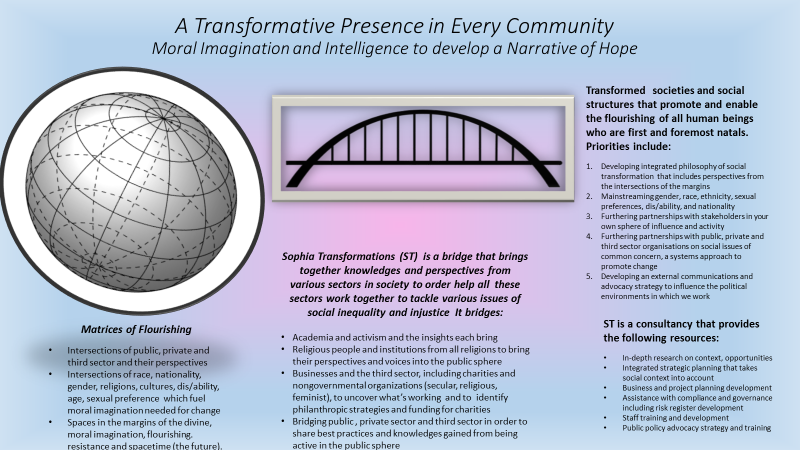SOPHIA TRANSFORMATIONS: A CONSULTANCY WITH A DIFFERENCE
INTRODUCTION TO SOPHIA TRANSFORMATIONS
Sophia Transformations looks at how best to facilitate social change and social transformation. This involves a world view shift from the dualistic one we have now which separates body, mind and spirit, to a more holistic one that integrates body, mind and spirit. Shifting our world world view includes developing a better understanding of what it means to be a human being, what it means to promote human flourishing or well-being for all people irrespective of their religion, gender, nationality, ethnicity, dis/ability, economic class, age and sexual orientation and which takes these identities and their intersections into account.
For example, one person could be a middle aged black disabled female professional. What does flourishing look like for her and how does all her different identities shape and continue to shape her given that our identities are never fixed, but are constantly in flux? This view of human nature assumes human beings are unique in that each individual is unique, but that we all have our humanity in common. Each person has a unique story and unique purpose and contribution to make to this world. Each person can become, grow and flourish.
Shifting our worldview includes developing a different perspective on what constitutes God, divinity, or the Transcendent in each community. Even those who don’t believe in God have a spiritual perspective and what constitutes divinity in a community is what constitutes those people and things which have the highest value in that community. Don’t worry, I will be unpacking this further in future blogs. It’s what some refer to as spiritual capital. However, I really don’t like this term as it monetises the most important thing to human beings, that which is beyond themselves which they can’t explain. Some refer to it as serendipity and others refer to it as the fifth dimension. It is something mysterious and inexplicable. You might also call it a sense of wonder.
Finally, the world view or philosophy under which ST operates and hopes to impart, is a view of time which I call spacetime. I will unpack this as well. But it means the past and future are active in the present. Interpretations of the past shape our stories and narratives of who we are individually and who we are collectively. These interpretations of the past can block future wellbeing or they can promote future flourishing. Often these narratives, these stories we tell about the past, need to be reframed. This is nothing new. Considering new experiences, we are constantly reinterpreting our past in order to account how we our identities are changing and growing.
Throughout in all consulting to charities, businesses and the public sector, ST will emphasize the importance of moral imagination and how to develop moral intelligence to address complex and difficult social issues. Some people are born with moral intelligence but it can be developed. In future blogs on this site and on my website, I will unpack what I mean by moral imagination and moral intelligence. For now, I will define moral imagination as the ability to think differently and creatively in each unique context (communities including local, national and international) about solutions that respect the dignity and rights of all human beings. Moral intelligence involves the ability to think flexibly and creatively in each situation about injustice and how best to provide moral and ethical solutions to these issues.

ST is a bridge. It bridges academia and activism and bridges the private, public and charitable sectors. Activists birth new understandings of solutions to problems and of society that academics need as part of reshaping their theories. Similarly, academics formulate new theories that need to be tested and tried in the world. Academics think new thoughts about institutions and new prototypes and models need to be developed to test them. Academics inform activists and activists inform academia. ST bridges the knowledges of both by researching and bringing the knowledge of both to each side of the bridge.
All three sectors, public, private and charitable, can collaborate together to solve today’s complex social issues as each sector has their own strengths and perspectives they can bring to bear on these issues. However, no one sector can solve these issues on their own. They are too complex.
ST will therefore serve as a bridge for knowledges and best practices developed by business and bring it into the Third Sector and vice versa. ST will help charities adopt best business practices from the private sector. Similarly, ST will help businesses find which charities and nongovernmental organisations to invest in. ST also seeks to help businesses develop new business models that address different aspects of human flourishing whilst still making a profit. ST hopes to provide resources and models to help charities and businesses imagine and create new models of working together more effectively and more holistically. I will be blogging about how this might happen and possible models how to work more holistically and better together in future blogs.
ST plans to bridge the business sector and the third sector (charities and nongovernmental organisations) together with the public sector. Government policies need to be better informed by the knowledges developed in the business and third sector. I will be writing blogs about how these three sectors intersect and how their unique perspectives and understandings can better influence and inform one another for the transformation of communities at all levels.
Finally, ST will provide resources to do this around the priorities listed in the third column of the diagram. These priorities include:
- Developing integrated philosophy of social transformation that includes perspectives from the intersections of the margins
- Mainstreaming gender, race, ethnicity, sexual preferences, dis/ability, and nationality
- Furthering partnerships with stakeholders in your own sphere of influence and activity
- Furthering partnerships with public, private and third sector organisations on social issues of common concern, a systems approach to promote change
- Developing an external communications and advocacy strategy to influence the political environments in which we work
These resources include in-depth research to help the sectors better understand the social, political, economic, national and international context in which they operate; the unique challenges and opportunities they face. ST will help to turn this research into strategies that takes these contexts into account. ST will assist and provide resources to enable with their strategic planning that take the public and private sector into account. ST will help the public and business sector organizations with their relationships with and understanding of the perspectives and knowledges gleaned in the charitable sector.
Other resources include assistance with developing business and project plans. ST can develop these plans or help existing staff through consultation and training to develop these plans. ST also aids charities with their governance and compliance issues including the development and/or critique of strategic and operational risk registers.
Finally, ST offers strategic planning and training around public policy and advocacy so they can more effectively influence government public policy at the local, national and international levels. For example, ST can train staff in human rights advocacy.
That’s all for now, but stay tuned as I write blogs that develop and explain each aspect of Sophia Transformation’s business model and what it has to offer to your charity, business or public sector organisation

